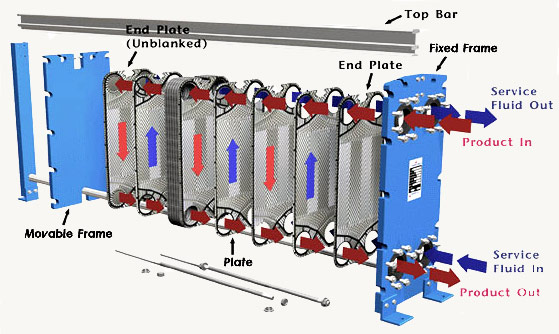Both the Shell and Tube and Plate Type heat exchangers work with the same principles, exchanging heat between two fluids through thermal conduction, but with very different construction methods. Both plate type and shell and tube heat exchangers are normally used on ships and have their advantages and disadvantages.
Plate Type Heat Exchanger
Advantages
1. Simple and compact in size.
2. Heat transfer efficiency is more.
3. Can be easily dismantled for cleaning.
4. No extra space is required for dismantling.
5. Capacity can be increased by introducing plates in pairs.
6. Leaking plates can be removed in pairs, if necessary without replacement.
7. Maintenance – cleaning is difficult (as surface is visible).
8. Turbulent flow help to reduce deposits which would interfere with heat transfer.
Disadvantages
1. Initial cost is high since Titanium plates are expensive.
2. Finding leakage is difficult since pressure test is not as easy as tube coolers.
3. Bonding material between plates limits operating temperature of the cooler.
4. Pressure drop caused by plate cooler is higher than tube cooler.
5. Careful dismantling and assembling to be done.
6. Over tightening of the clamping bolts result in increased pressure drop across the cooler.
7. Joints may be deteriorated according to the operating conditions.
8. Since Titanium is a noble metal, other parts of the cooling system are susceptible to corrosion.
Shell and Tube Heat Exchanger
Advantages
1. Less expensive as compared to Plate type coolers.
2. Can be used in systems with higher operating temperatures and pressures.
3. Pressure drop across a tube cooler is less.
4. Tube leaks are easily located and plugged since pressure test is comparatively easy.
5. Tubular coolers in refrigeration system can act as receiver also.
6. Using sacrificial anodes protects the whole cooling system against corrosion.
7. Tube coolers may be preferred for lubricating oil cooling because of the pressure differential.
Disadvantages
1. Heat transfer efficiency is less compared to plate type cooler.
2. Dismantling for maintenance is difficult since a tube cooler requires enough clearance at one end to remove the tube nest / accommodate the lancing tool and the end covers are relatively large & heavy.
3. Capacity of tube cooler cannot be increased.
4. Requires more space in comparison to plate coolers.
REFERENCE SOURCE:
“General Engineering Knowledge” by H.D. McGeorge
Guest Author Name: Aditya Malik
Social Profiles: ?
Short Bio: Trainee marine engineer opting for m.tech in marine engineering in U.K.
* The following article is partly produced as it is from Reference source for better understanding. Nor the blog owner or other permanent authors are responsible for any copyright claims. Inform us if you have any problem with the content.


















Post a Comment